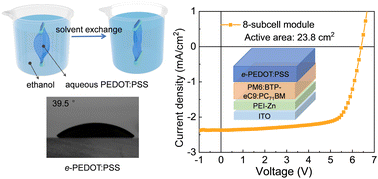Two-in-one alcohol-processed PEDOT electrodes produced by solvent exchange for organic solar cells†
Abstract
Poly(3,4-ethylenedioxythiophere):poly(styrenesulfonate) (PEDOT:PSS) is a common solution-processed electrode for printable organic solar cells. However, the water-dispersed PEDOT:PSS displays de-wetting issues when deposited on an active layer, which limits its application on printable top electrodes. In this work, we report a solvent exchange method to prepare alcohol-processed PEDOT:PSS. Spontaneous exchange of water and alcohol occurs when aqueous PEDOT:PSS in a dialysis membrane is immersed into alcohol. This is probably due to the polarity difference that induces different speeds to pass through the dialysis membrane. The residual PEDOT:PSS was further dispersed in ethanol and ethanol-based PEDOT:PSS (e-PEDOT:PSS) was obtained. The obtained e-PEDOT:PSS has good wetting ability and high electronic conductivity. The work function of e-PEDOT:PSS was tuned from 4.9 to 5.3 eV by adding an alcohol-based fluorinated formulation (PEDOT:F). The obtained formulation e-PEDOT:PSS was blade coated as the top electrode without additional hole-transporting layers (called 2-in-1 electrodes), and the fabricated devices based on e-PEDOT:PSS showed an efficiency of 14.02%.



 Please wait while we load your content...
Please wait while we load your content...